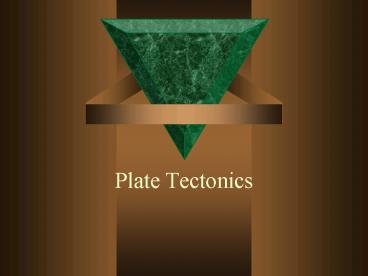Plate Tectonics - PowerPoint PPT Presentation
1 / 19
Title:
Plate Tectonics
Description:
Plate Tectonics Brief Structure of the Earth Divided into layers: Core, mantle, crust Brief Structure of the Earth Lithosphere Crust and upper part of the mantle ... – PowerPoint PPT presentation
Number of Views:233
Avg rating:3.0/5.0
Title: Plate Tectonics
1
Plate Tectonics
2
Brief Structure of the Earth
- Divided into layers
- Core, mantle, crust
3
Brief Structure of the Earth
- Lithosphere
- Crust and upper part of the mantle
- About 100 km thick
- Rigid
- Asthenosphere
- Plastic (gooey) layer beneath the lithosphere
- More dense than the lithosphere
4
Brief Structure of the Earth
- Continental Crust
- Made up of continents and edges of the oceans
- Light
- Oceanic Crust
- Made up of ocean floor
- More dense than continental crust
- Older oceanic crust is more dense than younger
oceanic crust
5
Theory of Plate Tectonics
- Developed in 1960s
- Combined continental drift and seafloor
spreading.
6
Theory of Plate Tectonics
- Stated that
- The crust and upper mantle (lithosphere) of the
earth are broken into sections called plates. - These plates sit on top of the plastic (gooey)
part of the mantle (asthenosphere). - These plates can move apart, converge, or slide
past one another through time.
7
(No Transcript)
8
Divergent Boundaries
- Where plates are moving apart and new crust is
forming. - Example Mid-ocean ridges
9
Convergent Boundaries
- Where two plates collide and crust is destroyed.
- Subduction zone
- Area where a dense oceanic plate sinks under a
light continental plate or another less dense
oceanic plate - Forms volcanoes.
- When two continental plates collide high
mountains are formed.
10
Transform Boundary
- Where one plate is sliding past another plate.
- The plates may be going in opposite directions or
the same direction at different rates. - Earthquakes are common
11
Modern Theories for Cause of Plate Tectonics
- All include convection currents in the mantle.
12
Convection Current
- Cycle of heating, rising, cooling, sinking
- Caused by differences in density due to
differences in temperature - Example boiling pan of water
13
Forces
- Movement of plates result in three types of
forces - Tension pulls rocks apart
- Compression pushes rocks together
- Shearing pushes rocks past each other
14
Fault
- Surface where rock has broken apart and moved.
- 3 types
- Normal fault
- Reverse fault
- Transform (or strike-slip) fault
15
Faults
- Normal fault
- Rock above the fault moves down.
- Formed by tension.
- Reverse fault
- Rock above the fault plane moves up.
- Formed by compression.
- Transform fault
- Bodies of rock slide past each other.
- Formed by shearing.
16
Features of Tension Forces
- Mid-ocean ridge
- Where oceanic crust is being pulled apart.
- Rift Valley
- Where continental crust is being pulled apart.
17
Features of Compression Forces
- Mountains
- Continental-continental collisions
- Very high mountains (folded mountains) are
formed. - Oceanic-continental collisions
- Volcanic mountains are formed.
- Oceanic-oceanic collisions
- Island arcs (volcanoes that reach above the
surface of the ocean) are formed.
18
Features of Shearing
- Earthquakes
- Rocks on each side of a strike-slip fault become
stuck in one place for a time and then move,
releasing energy in the form of an earthquake.
19
Tracking Plate Movement
- Plate movement is tracked using satellites and
lasers. - Current rates of movement range from about 1 cm
to about 12 cm per year.































